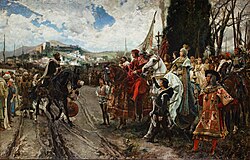Nasrid
dynasty
The Nasrid dynasty or Banuu Nasri (Arabic: بنو نصر) was the last Arab and Muslim dynasty in Spain. The Nasrid dynasty came to power after the defeat of the Almohad dynasty in 1212 at the Battle of Las Navas de Tolosa. Twenty-three different emirs ruled Granada from the founding of the dynasty in 1232 by Muhammed I ibn Nasr until January 2, 1492, when Muhammad XII of Granada surrendered to the Christian Spanish kingdoms of Aragon and Castile. Today, the most visible evidence of the Nasrids is the Alhambra palace built under their rule.

List of Nasrid Sultans of Granada change
- Muhammed I ibn Nasr (1238-1272)
- Muhammed II al-Faqih (1273-1302)
- Muhammed III (1302-1309)
- Nasr (1309-1314)
- Ismail I (1314-1325)
- Muhammed IV (1325-1333)
- Yusuf I (1333-1354)
- Muhammed V (1354-1359, 1362-1391)
- Ismail II (1359-1360)
- Muhammed VI (1360-1362)
- Yusuf II (1391-1392)
- Muhammed VII (1392-1408)
- Yusuf III (1408-1417)
- Muhammed VIII (1417-1419, 1427-1429)
- Muhammed IX (1419-1427, 1430-1431, 1432-1445, 1448-1453)
- Yusuf IV (1431-1432)
- Yusuf V (1445-1446, 1462)
- Muhammed X (1446-1448)
- Muhammed XI (1453-1454)
- Said (1454-1464)
- Abu l-Hasan Ali, known as Muley Hacén (1464-1482, 1483-1485)
- Abu 'abd Allah Muhammed XII, known as Boabdil (1482-1483, 1486-1492)
- Abū `Abd Allāh Muhammed XIII, known as El Zagal (1485-1486)
Genealogical chart change
Related pages change
References change
- William Montgomery Watt: A History of Islamic Spain, Edinburgh University Press, 1965 ISBN 0-7486-0847-8
Other websites change
- Genealogy of the Nasrid Kingdom of Granada (in Spanish)
- Genealogy of the muslim dynasties in Spain Archived 2008-11-13 at the Wayback Machine (in French)